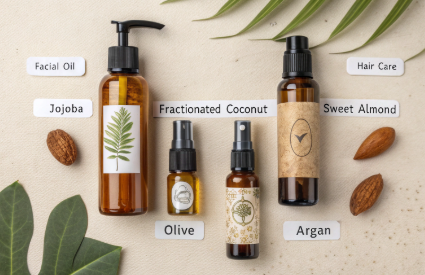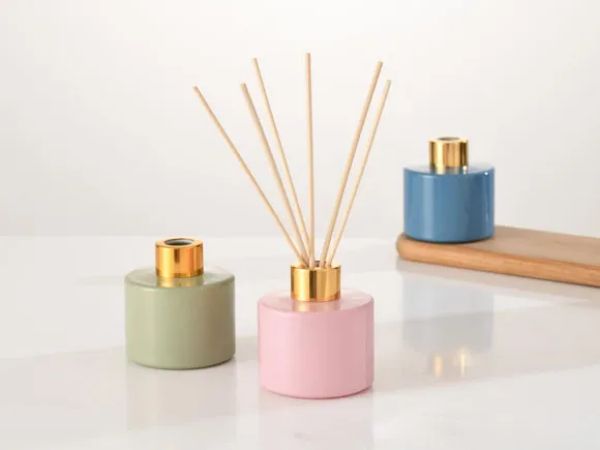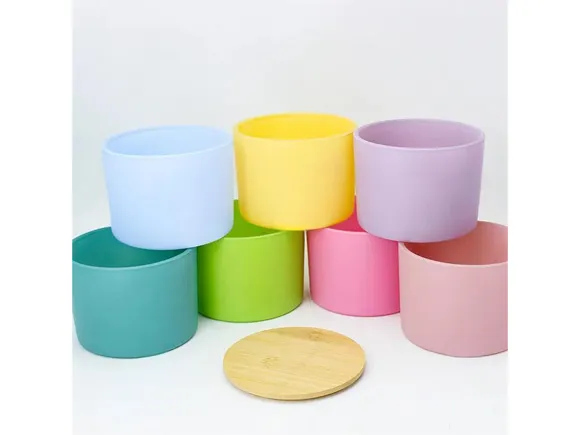Choosing the right carrier oil can make or break your essential oil formula. The wrong one can clog pores, irritate skin, or distort the scent—especially disastrous if you’re building a skincare or aromatherapy brand.
The best carrier oil for mixing essential oils depends on your application—but top choices include jojoba oil for skincare, fractionated coconut oil for massage, and sweet almond oil for versatility.
As a packaging supplier for aromatherapy brands, we’ve seen firsthand how the wrong oil choice can lead to returns, complaints, or product failure. Let’s break down how to get it right from the start.
What is the 30 50 20 rule for essential oils?
Creating essential oil blends isn’t just art—it’s chemistry. Without balance, your formula might smell harsh or evaporate too fast.
The 30-50-20 rule refers to blending essential oils using 30% top notes, 50% middle notes, and 20% base notes to create a balanced fragrance.
This helps structure the scent so that:
-
Top notes(like lemon, eucalyptus) offer the first impression
-
Middle notes(like lavender, rosemary) carry the core aroma
-
Base notes(like cedarwood, patchouli) add depth and longevity
Applying the 30-50-20 Rule
| Note Type | % of Blend | Function | Common Oils |
|---|---|---|---|
| Top | 30% | Fresh opening | Bergamot, Peppermint |
| Middle | 50% | Scent body | Geranium, Chamomile |
| Base | 20% | Lasting aroma | Sandalwood, Vanilla |
What is the best mix of essential oils?
While carrier oil matters, the essential oil blend defines your formula’s effect—relaxing, energizing, balancing, etc.
The best mix depends on your product goal—but blends like lavender + frankincense + bergamot are popular for calming, while peppermint + rosemary + lemon work well for focus.
Here are some proven combinations:
Proven Essential Oil Blends by Purpose
| Goal | Blend | Ratio Suggestion |
|---|---|---|
| Relaxation | Lavender + Bergamot + Frankincense | 3:2:1 |
| Energy Boost | Peppermint + Orange + Rosemary | 2:2:1 |
| Sleep | Chamomile + Clary Sage + Vetiver | 2:2:1 |
| Immune Support | Eucalyptus + Lemon + Tea Tree | 1:1:1 |
If you sell pre-diluted oils in roll-on bottles, choosing stable carrier oils (like jojoba or fractionated coconut) ensures consistent shelf life and scent delivery.
Which carrier oil penetrates the skin best?
Penetration is key—especially for skincare or therapeutic formulas. If the oil just sits on the surface, it won’t deliver nutrients or allow essential oils to do their job.
Jojoba oil is widely considered the best-penetrating carrier oil due to its molecular similarity to human sebum.
Here’s how others compare:
Top Uses for Jojoba Oil in Aromatherapy and Skincare
So, where does jojoba oil truly shine? Thanks to its unique affinity for our own skin's sebum, it’s an all-star in multiple routines:
-
Facial Moisturizer:Jojoba absorbs quickly without a greasy residue, making it perfect for daily moisture—even on those fussy T-zones.
-
Essential Oil Diluter:Blending essential oils for spot treatments? Jojoba’s excellent absorption means actives actually reach your skin (not just your pillowcase).
-
Soothing Massage Base:Its silky texture makes it ideal for massages—whether you’re chasing away knots or blending in calming oils like lavender or chamomile.
-
Targeted Treatment Oil:Tackling dryness or irritated patches? Jojoba’s vitamins (A, D, and E) and natural fungicidal properties make it a smart pick, particularly for those pesky winter elbows or post-shave rashes.
-
Long-Lasting Blends:Because jojoba resists oxidation, any homemade serums or blends you whip up will keep fresher, longer.
In short, if you want something light, balancing, and versatile for both aromatherapy and skincare rituals, jojoba oil is tough to beat.
Carrier Oils Ranked by Skin Penetration
| Oil | Penetration | Best For |
|---|---|---|
| Jojoba | Excellent | Face, acne-prone skin |
| Sweet Almond | Good | Massage, body oils |
| Grapeseed | Fast-absorbing | Oily skin |
| Avocado | Medium | Dry, mature skin |
| Coconut (Fractionated) | Light | Roller blends, hair oil |
What is a blending oil for essential oils?
Blending oils are just another name for carrier oils—used to dilute essential oils and "carry" them into the skin.
A blending oil is a neutral, skin-safe oil like sweet almond or jojoba that acts as a base for essential oil formulations.
The best blending oils have:
-
Little to no scent
-
Long shelf life
-
Skin compatibility
Top 5 Blending Oils and Their Benefits
| Oil | Texture | Scent | Best Use |
|---|---|---|---|
| Jojoba | Light, waxy | Neutral | Facial oils |
| Fractionated Coconut | Very light | Odorless | Massage, roll-ons |
| Sweet Almond | Smooth | Mildly nutty | General use |
| Olive Oil | Thick | Stronger scent | Healing blends |
| Argan Oil | Rich | Slightly nutty | Hair or anti-aging |
PauPack supports brands that formulate with these oils by offeringUV-protective amber bottles,fine mist sprayers, androller tipscompatible with thick or thin carrier oils. Packaging matters—especially when oil weight and stability vary.
How to Dilute Essential Oils for Safe Skin Application
Before you reach for that bottle of lavender or peppermint, remember: essential oils are concentrated and should never be applied directly to your skin. To use them safely, always blend your chosen essential oil with a carrier oil. This not only ensures the essential oil is evenly distributed, but it also helps your skin absorb the benefits without irritation. Carrier oils such as jojoba, sweet almond, or argan don’t just act as a buffer—they actually nourish your skin, keep it moisturized, and slow down the evaporation of the essential oil, helping the scent and effects last longer.
A good general rule is to mix 1-2 drops of essential oil into every teaspoon (about 5 mL) of carrier oil. Adjust the ratio if you’re working with children, those with sensitive skin, or potent oils. Always do a small patch test first, and consult reputable sources or professionals if you’re unsure.
By mastering proper dilution, you unlock the therapeutic benefits of your favorite oils—without the risk.
What Sets Fractionated Coconut Oil Apart?
If you’re wondering why fractionated coconut oil is so popular in blends, it comes down to its unique properties. Unlike regular coconut oil—which solidifies when temperatures dip—fractionated coconut oil remains liquid at room temperature. This means it pours easily, won’t clog up your bottles (or your drains), and blends seamlessly with essential oils. Plus, its light, non-greasy feel is a standout for crafting smooth, mess-free applications—perfect for both professional and DIY aromatic creations.
Why is fractionated coconut oil recommended for dry skin?
Fractionated coconut oil earns its place as a staple for dry skin thanks to its ultra-light texture and impressive hydration power. Unlike regular coconut oil, its molecules are broken down (fractionated), so it absorbs quickly without clogging pores or feeling greasy.
What sets this carrier apart?
- Long-lasting moisture:It softens rough or flaky patches and creates a protective layer to lock in hydration.
- Non-comedogenic:Safe for most skin types—no heavy residue, just silky and smooth skin.
- Gentle for sensitive skin:Its purity and absence of strong scent mean minimal irritation, even if your skin is fussy.
- Boosts blends:Fractionated coconut oil helps distribute essential oils evenly, improving absorption and performance, especially important for massage and roll-on formulas.
In short, if your product needs weightless yet powerful moisturization—fractionated coconut oil is a reliable, user-friendly choice for nourishing dry or irritated skin.
Precautions When Using Coconut Oil as a Carrier
When choosing coconut oil as a carrier, stick to fractionated coconut oil—it stays liquid at room temperature, making it far easier to blend and apply. Solid coconut oil (the kind you find in jars at the grocery store) tends to harden, especially in cooler climates, and can clog drains if you’re rinsing tools or containers. Not only does this make cleaning up more challenging, but a little plumbing drama is the last thing any budding formulator needs.
For effortless mixing, smooth application, and a headache-free cleanup, always opt for the liquidified fractionated option.
Is Blueberry Seed Oil Safe for Sensitive Skin?
If you're searching for a gentle option, blueberry seed oil fits the bill. Its lightweight, non-irritating nature makes it a popular choice among those with sensitive skin concerns. Along with its ability to nourish and fortify hair and nails, blueberry seed oil rarely triggers reactions—soothing without clogging pores or leaving a heavy residue.
Whether you’re formulating a delicate face serum or targeting brittle nails, this oil seamlessly blends into a range of personal care products, offering versatility without compromising on skin comfort.
Blueberry Seed Oil: Benefits as a Carrier Oil
Blueberry seed oil brings something special to the blending table. Packed with skin-loving vitamins A and E, it not only nurtures your complexion but also lends support to hair and nail health—a real all-rounder for DIY formulations. The naturally light texture and mild, nutty scent mean it absorbs quickly and won’t overpower your essential oil blends.
A noteworthy feature? Blueberry seed oil is rich in omega-3 fatty acids, renowned for their ability to calm and replenish the skin. If you’re crafting products for sensitive skin or looking to add a strengthening boost to serums, hair oils, or nail treatments, blueberry seed oil shines. Plus, its non-irritating qualities make it a gentle choice for almost any formula.
How does blueberry seed oil support hair and nail health?
Blueberry seed oil is a hidden gem for hair and nail care, thanks to its nutrient-rich profile and light texture. Sourced from cold-pressed blueberry seeds, this oil delivers a host of beauty benefits—in part because it’s naturally loaded with skin-loving vitamins.
- Rich in Vitamins A and E:These antioxidants are crucial for promoting hair strength and supporting nail growth. Vitamin E, in particular, is known to help reduce breakage and keep both strands and cuticles resilient.
- High in Omega-3 Fatty Acids:Blueberry seed oil boasts a notable omega-3 content, which nourishes the scalp, soothes skin, and locks in moisture—making it a gentle choice for sensitive types.
- Lightweight, Fast-Absorbing:Unlike heavier oils, it won’t leave a greasy feel or weigh hair down. Its subtle, nutty scent also makes it a pleasant addition to leave-in formulas or hand balms.
If you’re targeting brittle nails, dry cuticles, or frizz-prone hair, blueberry seed oil serves as an excellent supporting ingredient in serums, conditioner oils, and nail treatments. It works well both on its own or blended with other favorites like jojoba or sweet almond.
Conclusion
The best carrier oil depends on your blend’s purpose—but jojoba, sweet almond, and fractionated coconut are versatile, skin-friendly favorites that support product performance and customer trust.














